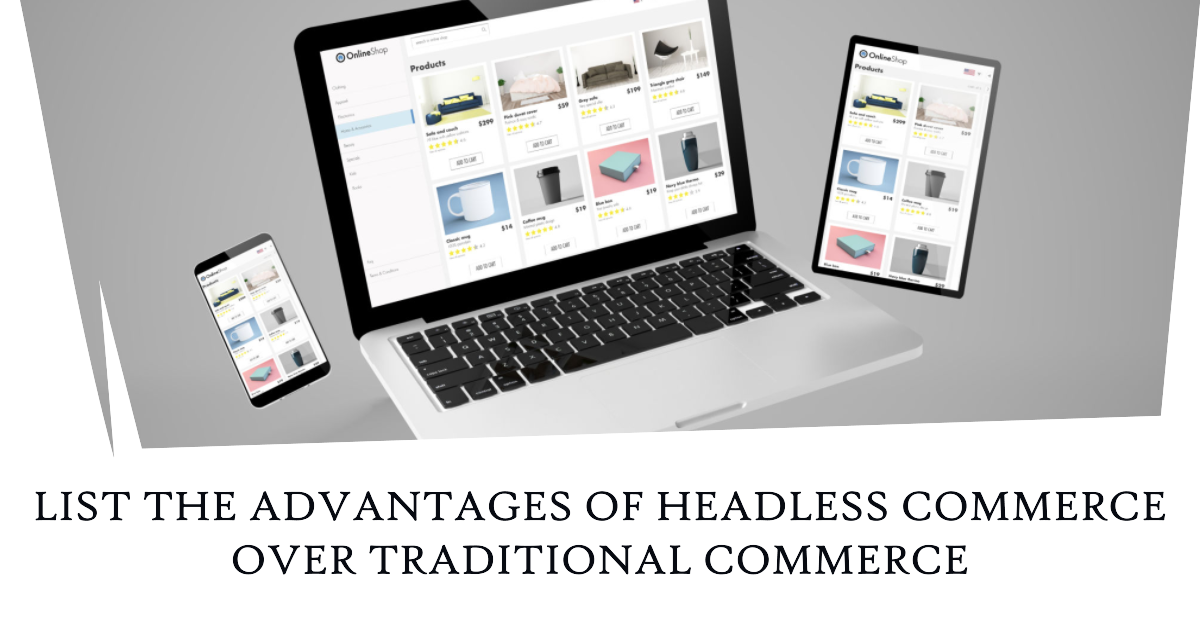eCommerce
List The Advantages Of Headless Commerce Over Traditional Commerce

If you run a business, you’re probably aware of the advantages of having an e-commerce site. E-commerce sites help you increase the efficiency of your business processes and have a direct link to your customers. However, building an e-commerce site from scratch might be difficult for most business owners.
As a result, many traditional commerce service providers created traditional CMS platforms which integrate both the front-end side of an e-commerce site and the back-end side into one common platform. While this increased efficiency for most business owners, it was very limiting for companies that wanted to customize their e-commerce platform for more functionality.
That is why headless commerce has become a very popular option in the past few years.
Understanding Headless Commerce
Headless commerce platforms create a clear distinction between the back-end side of processes and the customer or front-end side. Headless commerce simply provides the back end or server side of the e-commerce platform. That means they engage in order consolidation, customer service, and running the entire database of the e-commerce platform.
That leaves the business owner with the responsibility of developing a front-end side for the business and designing it in whichever way they want to.
What Are The Advantages Of Headless Commerce?
Headless commerce might look like a system that gives business owners more work when creating an e-commerce platform. But the advantages of such a system can prove invaluable for any type of business owner.
Here are just a few of them:
1. Enhanced Flexibility
Traditional commerce systems limit a business owner to specific packages when creating an e-commerce platform. The business owner has to choose the existing templates and try to force them to serve their business needs. So you can imagine how disadvantageous this can be when the platform does not provide sufficient templates. Have you ever seen an e-commerce site and was perfectly certain that you have seen a similar site somewhere before? That is just one of the drawbacks of traditional commerce systems.
Headless commerce allows a business to customize its front-end side to whichever form they want. That helps the business explore its creativity and create a front end that customers will enjoy. Gone are the days when the business would have to make do with existing templates.
2. Easy Integration To Existing Systems
Another drawback of traditional commerce is how hard it is to integrate it with existing systems. When switching to a traditional commerce package, you will have to completely overhaul your existing processes. That means forcing your customers to get acquainted with a new way of doing things. Many customers are likely to get lost in the cracks during the transition.
With headless commerce, switching from one platform to another is as simple as changing the back-end side using a new API. You can switch among different headless commerce without affecting the front-end side that customers interact with. Your customers will never feel the strain, no matter how many times you switch.
3. Omniplatform Capabilities
Most traditional commerce systems offer a limited number of applications. For most platforms, you can only create an e-commerce website for your customers. But what happens if your customers want a multiplatform experience? Will you force all your customers to use websites when they can download mobile apps and have an enhanced experience?
The only way you can enjoy omniplatform capabilities and the freedom to have different front-ends for your customers is by using headless commerce. All you will need to do is create a new front-end application and use an API to connect the headless system to your new front-end.
4. Simple Management
Managing a headless system is a very simple process. Your tech team can easily work on one part of the system without having to wait for other developers to finish their work on other parts. If a front-end engineer wants to add a new button to the web app, they can do so without affecting the server side or the front end for other interfaces.
That was impossible for a traditional commerce system. Since traditional commerce systems are all intertwined, developers had to work together and wait for each other if they wanted to make any changes.
You can imagine how much time is wasted when one developer has to wait for another to push their code. That is time the developer could spend creating exceptional tools for your e-commerce site.
5. Future Proof
Technology is always changing. Most of the front-end frameworks that people were using two years ago are outdated today. The only way your e-commerce site can keep up with changing technology is if you use headless commerce.
When you use a headless commerce system, you can easily assimilate your site to the changing trends without needing to perform a complete overhaul of the system. That means your e-commerce platform will always be up-to-date and booming with the latest features modern technology can offer.
Final Thoughts
The future of e-commerce is headless commerce. Traditional commerce systems served their time. They offered simplicity and an opportunity for non-tech savvy people to join in the ecommerce bandwagon.
But if you want to remain competitive and save a lot of money while still at it, you need to consider switching to headless commerce. Headless commerce provides a wide range of advantages that will allow you to customize your e-commerce site to its best identity.
So what are you waiting for? Switch today!
-
Blog1 year ago
MyCSULB: Login to CSULB Student and Employee Portal – MyCSULB 2023
-
Android App3 years ago
Cqatest App What is It
-
Android1 year ago
What Is content://com.android.browser.home/ All About in 2023? Set Up content com android browser home
-
Software2 years ago
A Guide For Better Cybersecurity & Data Protection For Your Devices
-
Latest News2 years ago
Soap2day Similar Sites And Alternatives To Watch Free Movies
-
Android2 years ago
What is OMACP And How To Remove It? Easy Guide OMACP 2022
-
Android3 years ago
What is org.codeaurora.snapcam?
-
Business2 years ago
Know Your Business (KYB) Process – Critical Component For Partnerships






















